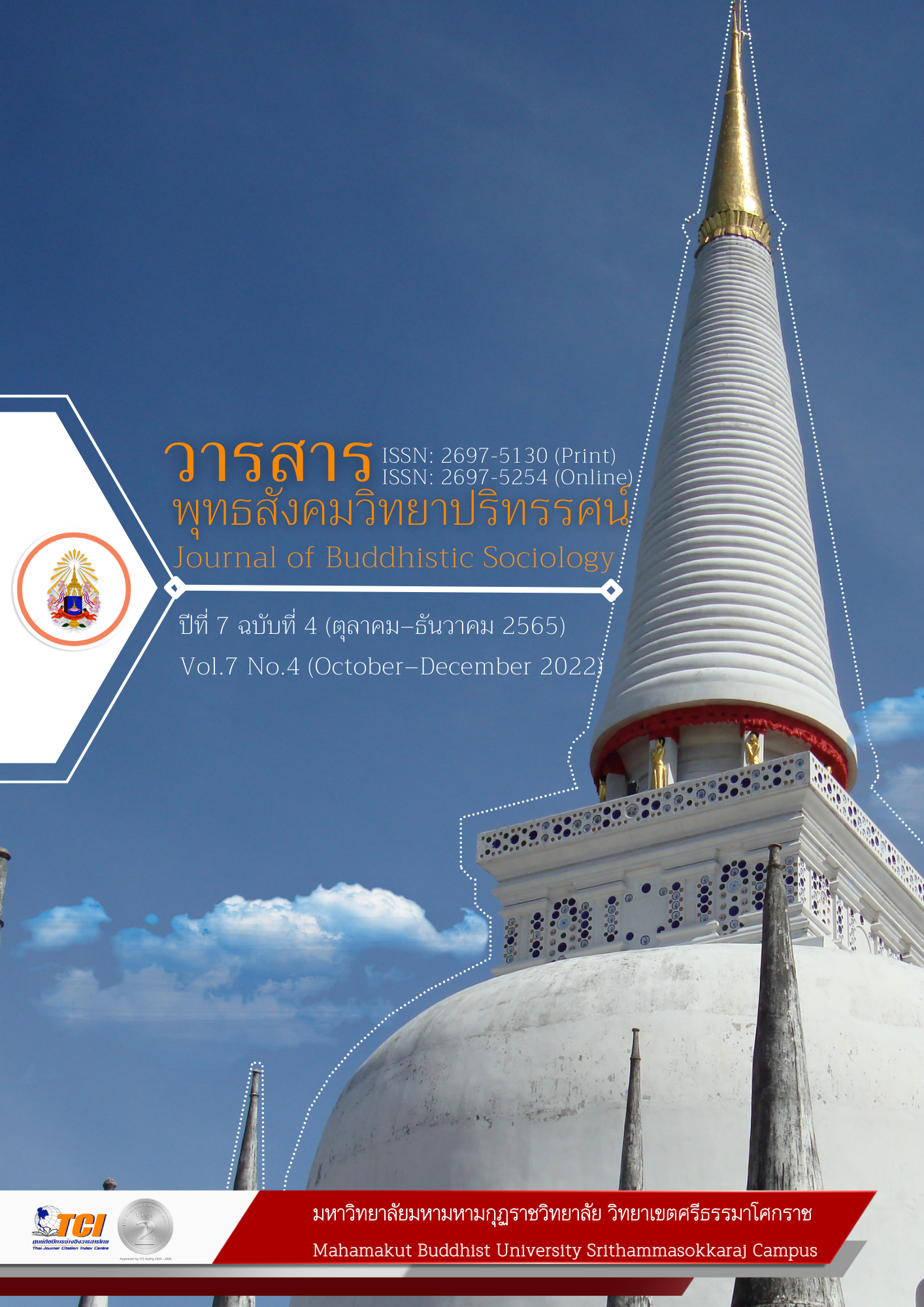THE EVALUATION OF STUDENT CARE AND SUPPORT SYSTEM OF NAITAOPITTHAYAKOM SCHOOL UNDER THE SECONDARY EDUCATIONAL SERVICE AREA OFFICE TRANG KRABI
Main Article Content
Abstract
The research aimed to 1) Context Evaluation, 2) Input Evaluation, 3) Process Evaluation, and 4) Product Evaluation. The sample groups were educational institute administrators, teachers, school committees. The sample groups used in the research were educational institution administrators, teachers, and educational institutions committees. There were 177 parents, students, and students at Naitaopitthayakom School. The research instruments were two questionnaires and an in-depth interview form. The statistics used for data analysis were percentage, mean, and standard deviation. and content analysis.
The results showed that;
- For context, the item with the highest mean was the project was appropriate and necessary for problem solving. The item with the lowest mean was the activities of the project could be put into practice.
- For inputs, the item with the highest mean was sufficient materials, equipment, and tools used in the project. The item with the lowest mean was the administrators and teachers who were in charge of the project were ready to implement the project.
- For process, from the item with the highest mean was clear and appropriate identification of the procedures, details and implementation of the project. The item with the lowest mean was there was a systematic and continuous assessment of the student care and support system project implementation by using a variety of methods for all activities, disseminating and expanding the student care and support system project to communities. From the item with the highest mean was giving knowledge, clarification, and communication with responsible and related people in order to clearly understand the procedures and implementation of the project. The item with the lowest mean was planning clear project implementation.
- For outputs, from the item with the highest mean was all activities specified in the student care and support system project were implemented. The item with the lowest mean was students were emotionally stable and had good relationship with others. From the item with the highest mean was all activities specified in the student care and support system project were implemented. The item with the lowest mean was students knew their aptitudes, abilities, interests, strength, and weaknesses and they were always ready to improve and develop themselves.
Article Details

This work is licensed under a Creative Commons Attribution-NonCommercial-NoDerivatives 4.0 International License.
References
กรมสุขภาพจิต. (2558). คู่มือครูที่ปรึกษาระบบการดูแลช่วยเหลือนักเรียน. กรุงเทพมหานคร: โรงพิมพ์องค์การรับส่งสินค้าและพัสดุภัณฑ์ (ร.ส.พ.).
กระทรวงศึกษาธิการ. (2560). การดำเนินงานระบบการดูแลช่วยเหลือนักเรียนในสถานศึกษา. กรุงเทพมหานคร: โรงพิมพ์องค์การรับส่งสินค้าและพัสดุภัณฑ์ (ร.ส.พ.).
กฤดิ์ทรัพย์ เชื้อพันธ์. (2562). ระบบดูแลช่วยเหลือนักเรียน. พระนครศรีอยุธยา: โรงเรียนอยุธยานุสรณ์.
จิรัฐิพร จีนสายใจ. (2557). ระบบดูแลช่วยเหลือนักเรียนในโรงเรียนโสตศึกษาจังหวัดนครปฐม. ใน การค้นคว้าอิสระปริญญาการศึกษามหาบัณฑิต สาขาวิชาการบริหารการศึกษา. มหาวิทยาลัยศิลปกร.
ทนงศักดิ์ บุญมี. (2555). ปัญหาการดำเนินการระบบดูแลช่วยเหลือนักเรียนในโรงเรียนสังกัดองค์การบริหารส่วนจังหวัดราชบุรี. ใน วิทยานิพนธ์ปริญญามหาบัณฑิต. มหาวิทยาลัยบูรพา.
ประนอม แก้วสวัสดิ์. (2556). สภาพและปัญหาการดำเนินงานระบบดูแลช่วยเหลือนักเรียน ในโรงเรียนสังกัดสำนักงานเขตพื้นที่การศึกษามัธยมศึกษา เขต 18. ใน วิทยานิพนธ์ครุศาสตรมหาบัณฑิต สาขาวิชาการบริหารการศึกษา. มหาวิทยาลัยราชภัฏรำไพพรรณี.
ปิยะวุฒิ ศรีชนะ. (2559). การประเมินโครงการระบบดูแลช่วยเหลือนักเรียนโรงเรียนโพนงามพิทยาคาร จังหวัดยโสธร สังกัดสำนักงานเขตพื้นที่การศึกษามัธยมศึกษา เขต 28. ยโสธร: โรงเรียนโพนงามพิทยาคาร.
มธุริน แผลงจันทึก. (2554). การศึกษาปัญหาการดำเนินงานระบบดูแลช่วยเหลือนักเรียนของโรงเรียนในสังกัดสำนักงานเขตพื้นที่การศึกษาประถมศึกษานครราชสีมา เขต 5. ใน วิทยานิพนธ์ครุศาสตรมหาบัณฑิต สาขาวิชาการบริหารการศึกษา. มหาวิทยาลัยราชภัฏชัยภูมิ.
ราชกิจจานุเบกษา. (2542). พระราชบัญญัติการศึกษาแห่งชาติ พุทธศักราช 2542. กรุงเทพมหานคร: โรงพิมพ์ คุรุสภา.
สำนักงานคณะกรรมการการศึกษาขั้นพื้นฐาน. (2559). แนวทางการดำเนินงานระบบดูแลช่วยเหลือนักเรียนสำหรับโรงเรียนขนาดเล็ก. กรุงเทพมหานคร: สำนักวิชาการและมาตรฐานการศึกษา.
สุจิตรา ช่วงโชติ. (2556). ปัญหาและแนวทางการพัฒนาระบบดูแลช่วยเหลือนักเรียนของโรงเรียนปัญญานุกูล สังกัดสำนักบริหารงานการศึกษาพิเศษ. ใน วิทยานิพนธ์ปริญญาศึกษาศาสตรมหาบัณฑิต สาขาวิชาการบริหารการศึกษา. มหาวิทยาลัยบูรพา.
อะห์หมัด สาและ. (2562). การประเมินโครงการพัฒนาระบบการดูแลช่วยเหลือนักเรียนโดยใช้กลยุทธ์ Kohchan Family โรงเรียนบ้านเกาะจัน. ปัตตานี: สำนักงานเขตพื้นที่การศึกษาประถมศึกษาปัตตานีเขต 2.
อาสณี นิสาแล๊ะ. (2555). การประเมินโครงการระบบดูแลช่วยเหลือนักเรียนในโรงเรียนแย้มจาดวิชชานุสรณ์สำนักงานเขตบึงกุ่ม กรุงเทพมหานคร. ใน ปริญญานิพนธ์มหาบัณฑิต สาขาวิชาการบริหารการศึกษา. มหาวิทยาลัยศรีนครินทรวิโรฒ.
Krejcie, R. V. & Morgan D. W. (1970). Determining Sample Size for Research Scillities. Education and Phychological Measurement, 30(3), 607-610.
Stufflebeam, Danial L. et al. (1997). The CIPP Model for Evaluation. In Kellaghan, T. & Stufflebeam, DL (Eds.). The International Handbook of Educational. Boton: Kluwer.


